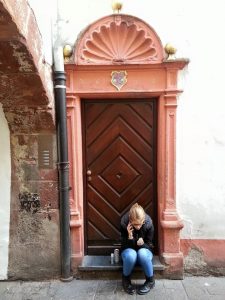“Ante Romam Treveris stetit annis mille trecentis” (Trier stood 1300 years before Rome) – legend of Trier’s founding.
Trier is the UNESCO World Heritage city you’ve never heard of. While you were busy swooning over Berlin’s modern architecture or Munich’s copious beer gardens, you’ve missed Germany’s most remarkable city, quietly minding its own business along the banks of the Mosel river, the way it always has for two and a half millennia. Visiting Trier puts the visitor in a bind – should she primarily focus on Trier’s Roman or more “recent” medieval history – both are abundant and extraordinary. The city is home to an incredible nine UNESCO World Heritage Sites. Nine! In one city. That is a quarter of all UNESCO sites in the entire country of Germany! To put that further into perspective, London has four such designations while major world destinations such as Berlin, Mexico City, Beijing, Moscow and New Dehli have only three each. So what is it that makes Trier so special? Where does one begin…. It could be that it is Germany’s oldest city. Perhaps it is the fact that Germany’s oldest standing bridge (over 2000 years) is, remarkably, still in regular use in Trier. Or that Germany’s oldest pharmacy, dating back to the middle ages, still serves the ill and the infirm. It could be that it’s Roman and medieval buildings are still standing in astonishingly good condition. Perhaps it is Trier’s beautiful location nestled among rolling hills along the banks of the Mosel river. Possibly, it is the fact that Trier is the home of the Riesling wine. Maybe Trier is special because it was the largest Roman city north of the Alps. Or perhaps because multiple Caesars decided to make Trier their principal residence. Could it be that the seal of the city is the oldest in all of Europe? Maybe it is all of these reasons, and then some more.
Roman Trier
Trier is located in Rheinland-Pfalz, in the picturesque German countryside near the border with Luxembourg. It was conquered by Roman armies in the first century B.C.E. and its location along the river Mosel marks the ancient frontier between Roman-occupied Gaul (modern France) and Germania, a land that forever evaded Rome’s conquest.
That, however, did not stop Rome from making it the cornerstone city of the northern empire. Several emperors made their residence here, including Constantine. [Yes, that would be the Constantine, one of the most influential Caesars, who converted the empire from paganism to Christianity.] In fact, the ruins of the Caesar’s northern palatine lie just a few kilometers outside of town. Clearly, Trier’s importance to the Roman empire cannot be understated.Entire books have been written on Trier’s many noteworthy sites, from Roman baths to the gladiator circus to the immense throne room of Constantine – the largest ever built by Rome – and much, much more. Unequivocally though, my favorite site is the “Porta Nigra,” the aptly named Black Gate. Four of these massive, four-story stone fortresses once guarded the entrances to the city. Only one still stands today. The Porta Nigra, pride of Trier, is in exceptional good condition and visitors are free to wander through this impressive fortification. It stands today as a testament to Roman engineering and military prowess. I recall running through its corridors and climbing its defenses as a child, imagining that I was a Roman centurion hurling spears at the hordes of furious barbarians below. Today, as an adult, I run my hands along the curved stones of the Porta Nigra and feel as if I’m teleported back to the time of the Caesars.
Medieval and Renaissance Trier
While Trier’s political glory days departed along with Rome’s legions, it set the stage for another evolution. It emerged from the medieval ages into the renaissance having endured plagues, violence (including a sacking by the Vikings,) and the racist expulsion of its Jewish population. Parts of the Jewish quarter are still standing, it’s 500+ year old buildings and wood-framed alleys bearing silent witness to history’s dark truths.Trier also took on a particularly important role in the Christian church of the middle ages – it became the principle home of Germany’s archbishops and at least one pope originated from Trier. The central market and pedestrian zone offers visitors the opportunity to view many well-preserved and beautiful old buildings, including Germany’s oldest pharmacy.
Leisurely Trier
For the wine lover, Trier is yet another destination. It is surrounded by the hills of the beautiful Mosel valley, in the heart of German wine country. Is it possible that Germany’s wine tradition was started by foreign colonizers? It’s quite likely. What I do know is that this considered the traditional home of the Riesling wine. Leisurely boat tours can be taken up and down the Mosel, the banks of the river dotted with wineries and hilltops dotted with ancient castles. Luxembourg is just a short drive away, and greater Trier’s hilly country roads are perfectly suited for exploration by car.
If you’ve never heard of Trier before, you’re not alone. For some strange reason, this gem of history is fairly unknown outside of Germany. Even Germans tend to underestimate it. A childhood friend of mine who has lived only an hour from Trier his entire life had never bothered to visit until I invited him for a day trip because “Ich dachte es wäre nur für Bauer” (“I thought it was only for farmers.”) Trust me, Trier is anything but a cow town. It offers several days worth of sight seeing and leisurely meandering, far more than I can fit into this one article. If you’re into history, wine, beautiful scenery, or just want to spend some days vacationing away from the throngs of tourists in Berlin or Munich, Trier is the place for you.
- Lowen Apotheke, Germany’s oldest pharmacy
- Markings on a column inside Porta Nigra
- An underground Roman cistern serves as a music store today
- More ‘recent’ architectural legacy of Trier
- Trier more “recent” history















Leave a Reply